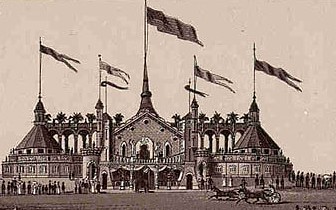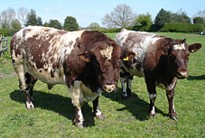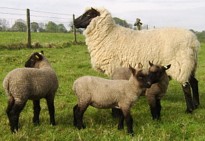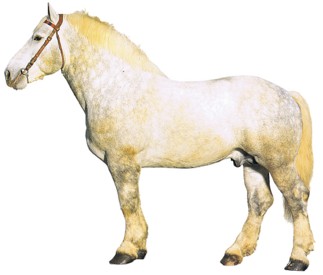AGRICULTURAL HISTORY of RINGGOLD

The earliest and subesquent settlers to Ringgold County were primarily farmers. They established homesteads where the prairie grass grew tall and the sod
looked promising. H. T. MILLER of Clinton Township introduced bluegrass into the county. Believing that bluegrass was a basis for stock raising, MILLER
shared his opinion with other farmers who widely agreed. Properly cut and cured, the grass made excellent hay and was vitamin-rich for grazing animals. Bluegrass
grew naturally and soon was growing in most of the 128,000 acres of Ringgold County pastureland. Most of the southern Iowa counties became conscious enough about
bluegrass that the Blue Grass League was organized in 1889 with 18 counties represented in the membership. The league was organized in Creston, Iowa, the center of the
organization. Taking a clue from the Corn Palace of Sioux City, the members sponsored the building of a Blue Grass Palace at the Union County fairgrounds (Creston) on May
11, 1889. The Palace opened on August 29, 1889, featuring exhibits which included all types of local soil products. The venture was such a success that plans were made to
make a bigger and better palace in 1890. This second palace was constructed from 76 varieties of native southern Iowa lumber. One of the features of the second palace was
an 18-foot suspension bridge that stretched between the north and south towers. Governor Horace BOIES officially opened the second exposition which was visited by more
than 4,000 people on the first day. The League sponsored fairs in 1891 and 1892. After that interest waned and there were no more blue grass expositions.
 The first Ringgold County Fair Association was organized in June of 1859. Members paid $1.00 annual dues which entitled the holder free admission at
the fair gates. The first Ringgold County Fair was held in the Fall of 1859 on the courthouse square with $42.50 paid out in award premiums. Several
diplomas were awarded for the best entries.The second county fair, also on the courthouse square, was held October 15 and 16 of 1860, boasting 336 entries.
Optimistic, officials hoped to have a fairground in the near future.
The first Ringgold County Fair Association was organized in June of 1859. Members paid $1.00 annual dues which entitled the holder free admission at
the fair gates. The first Ringgold County Fair was held in the Fall of 1859 on the courthouse square with $42.50 paid out in award premiums. Several
diplomas were awarded for the best entries.The second county fair, also on the courthouse square, was held October 15 and 16 of 1860, boasting 336 entries.
Optimistic, officials hoped to have a fairground in the near future. In 1868, Charles W. DRAKE deeded a 40-acre tract of his land to the Ringgold Agricultural
Society for the purpose of establishing a fairground. The tract of land was located on a beautiful site about a mile northeast of Mount Ayr. The property was valued
at $1,500 in 1887. During the Civil War, Ringgold County did not hold a fair until a year after the close of the War on October 4, 1865. Various amusements were added
until 1885, adding more interest to the exhibits of livestock, fruits and vegetables, and horse racing. Year later, general interest in the fair waned with the unjust pro-rating
of premiums and a monopoly of horse racing management. Ultimately the fair grounds were abandoned in 1898. Afterwards, Mount Ayr held only street fairs.
Corn and oats were the staple crops raised in Ringgold County. Judson GRIFFITH who came from Ohio in 1854 attempted to raise cotton for a couple of years without much success.
Many farmers combined grain and stock raising. Somewhat isolated, the farmers had some difficulty getting their stock to market. Luke SHAY did his own butchering and then
hauled the meat by wagon to St. Joseph, Missouri. Later, when the railroad came through, SHAY drove his hogs and cattle to the nearest rail town for shipment to market.
Cyrus B. DAMEN, a farmer who settled in Jefferson Township in 1859, drove his hogs to market at Afton. In 1861, John DICKSON and Sylvester BEAVER herded a flock of 600 sheep
in from Union County, an endeavor which took them two months to complete. During the early years of settlement in Ringgold County, the pioneers traveled from 50 to 100 miles
to the nearest store or mill. Groceries were scarce and high. Salt sold for ten dollars a barrel or seven-cents a pound. Early store owners had to travel as far as the pioneers
to restock their shelves. At times sugar was so scarce that the women made watermelon and pumpkin molasses as a substitute.
 The early settlers wondered whether fruit trees would be productive in Ringgold County. In 1855, Samuel FELLOWS settled near
Crooked Creek. He decided to plant an orchard on his land. Pete DOZE, then the sheriff, laughed and then advised him that he
shouldn't "fool away his time setting out trees." FELLOWS pointed out that since wild crab apple and plum trees produced fruit,
so should other fruit trees. So successful was FELLOWS orchard that Pete DOZE's wife planted the pits from a bushel of peaches
he had brought home from Missouri. Mrs. DOZE, like Samuel FELLOWS, had good luck with her orchard of peach trees.
The early settlers wondered whether fruit trees would be productive in Ringgold County. In 1855, Samuel FELLOWS settled near
Crooked Creek. He decided to plant an orchard on his land. Pete DOZE, then the sheriff, laughed and then advised him that he
shouldn't "fool away his time setting out trees." FELLOWS pointed out that since wild crab apple and plum trees produced fruit,
so should other fruit trees. So successful was FELLOWS orchard that Pete DOZE's wife planted the pits from a bushel of peaches
he had brought home from Missouri. Mrs. DOZE, like Samuel FELLOWS, had good luck with her orchard of peach trees. While FELLOWS
and Mrs. DOZE experimented with their orchards, other farmers in Ringgold County began raising sheep. Captain Andrew JOHNSTON of
Liberty Township and Charles K. GRIMES were among the early sheep producers. JOHNSON, who came to Ringgold County in 1856, tended to a
a flock of 700 head. During the Civil War, the flocks provided the much needed wool for blankets and uniforms. Regardless of how
carefully a flock was tended, wolves were a constant threat. In 1858, a law which provided a bounty on the scalps of wolves and other
such marauding vermin was enacted. The bounty was so low that the Iowa Sheepbreeders and Wool Growers asked that it be raised,
believing that would help take care of the problem. Even with a bounty on their heads, the wolf population increased. The Iowa Homestead
commented in 1892 that some Iowan farmers might be raising wolves to collect the bounty. From 1913 to 1919, the State of Iowa paid $150,000 in
bounties. Ringgold County paid $3,759 in bounties from 1918 to 1938. Taking the matter in his own hands, John SNEER obtained a pair of hounds
and set out to hunt down the wolves. Hot on the hunt, the hounds brayed all over the countryside, distrubing the neighbors more than they did
the wolves. Occasionally hounds were used in a circular wolf hunt. The hunters positioned themselves in a circle which encompassed so many
miles of territory. Then the men and hounds closed in toward the center of the circle. During the Civil War, the farmers of Ringgold County
began to utilize the farm implements that were on the market. Osman LINIGER purchased the county's first threshing machine in 1862 for $500, paid for
entirely in cash. Sy CROSLEY bought a "down power" threshing machine, operated by four or five teams of horses. Then, in 1869, Levi TERWILLIGER
purchased the first corn planter in the county. The Patrons of Husbandry organized the farmers' Grange in almost every township during the 1870's.
The Grange organizations existed for ten or so years, providing a social organization which included the farm women and children. Through the grange,
a farmer found a means to voice a unified protest against seemingly unfair state and federal legislation. Through the national voice of the Grange,
the cabinet office of the Secretary of Agriculture was established. In Iowa, the Grange lobbyists supported the farmers in their fight against
high freight rates. This brought about the Granger law which called for freight and passengers fares to be set by the State instead of the railroads. A few years
later the Granger law was repealed however the Railway Commission was organized as a permanent state means to mediate disagreements between farmers
and the railroads. In 1870, the Iowa Board of immigration published a pamphlet stating that the farmers of Ringgold County were doing quite well.
24,651 acres were under cultivation with a harvest of 24,482 bushels of wheat, 426,840 bushels of corn, and 51,401 bushels of oats. The farmers had
16,577 head of sheep, 9,362 head of hogs, and 5,961 head of cattle. (After the passage of the herd law in 1870 which banned the habit of open range grazing,
the number of sheep and hogs dwindled.) Ringgold County also had 2,659 horses, 116 oxen, and 204 mules. During the year, the county's farmers sold $142,206
worth of livestock. With the passage of the 1870 herd law, the farmers were forced to address the issue of fencing. Often, it cost more to set a fence around
the homestead than what the land initially cost. One solution was the placement of osage orange hedge rows around the property. Once the railroads came to
Ringgold County, pine fencing became popular. In time barbed wire, which was more affordable, solved the problem for most farmers. Meanwhile, many farmers
gave up raising hogs and sheep after the herd law was enacted. Primarily, one great problem for the farmers was the difficulty of keeping their sheep fenced in.
 Several farmers sold their flocks and turned their attention to raising cattle. Around the year 1875, Captain Andrew JOHNSTON came back from the Iowa State Fair
with two purebred Shorthorns, Beulah and Young Mary. These two heifers were the foundation for Capt. JOHNSTON's herd. He frequented
many state and county fairs, buying Shorthorn cattle from noted breeders. When Capt. JOHNSTON disposed of his herd of 28 Shorthorns, he received an average of
$700 a head for them. Capt. JOHNSTON's influence encouraged other area farmers to improve upon their herds.
Several farmers sold their flocks and turned their attention to raising cattle. Around the year 1875, Captain Andrew JOHNSTON came back from the Iowa State Fair
with two purebred Shorthorns, Beulah and Young Mary. These two heifers were the foundation for Capt. JOHNSTON's herd. He frequented
many state and county fairs, buying Shorthorn cattle from noted breeders. When Capt. JOHNSTON disposed of his herd of 28 Shorthorns, he received an average of
$700 a head for them. Capt. JOHNSTON's influence encouraged other area farmers to improve upon their herds. A. T. KINSELL introduced a herd of Hereford cattle into the
county in 1886. A. INGRAM built up one of the finest herds in the county from his imported Herfords. They won top honors at the 1900 Iowa State Fair. T. A. STEVENSON
introduced Aberdean Angus cattle into the county around the year 1890. Briggs WILBUR raised Holsteins and many farms had a Jersey cow for the family's dairy supply. Daniel TIDRICK of Liberty Township raised Poland China
hogs and Norman and Clydesdale draft horses. TIDRICK's livestock won many prizes at the fairs. The farmers in one section of the county experienced quite a bit
of problems with an outbreak of hog cholera in 1876 and 1877. This may account for the sudden decline of hogs being raised in Ringgold County during the 1870's along
with the 1870 herd law. John BLAUER came to Ringgold County in 1881. He established a farm which was called Evergreen Dairy Farm. In 1883, BLAUER netted $450 on the
sale of his butter from his herd of twelve cows. Several other area farmers kept a small herd of dairy cows, selling the cream when they came to town to conduct
business on Saturday. In 1884, Briggs WILBUR founded a creamery in Liberty Township and soon converted it into a cheese factory which was quite properous for a number
of years. Since 1876, Ringgold County was well-known for its fine horses, purebred Percherons, Normans, Clydesdales, English Shires, and Belgians along with Cleveland
bays and French coach horses. Melvin BENNETT, who raised French coach horses, owned the fastest stallion in southwestern Iowa. E. N. DEWITT and his brothers ran the livery
stable in Tingley. Some of the DEWITT stallions won the sweeptake prizes at the Illinois State Fair and other local county fairs. Often, the DEWITTS paid as much as
$2,500 for their breeding stock. D. D. McGREGOR of Tingley had a reputation of raising the best draft horses in the county. Many of his animals weighed in from 1,800 to
2,300 pounds each. During the 1890's, several horse companies flourished in Ringgold County. One, the Liberty Township Horse Company, was organied by Norm ROGERS, S. F. LOWDER,
D. C. TIDRICK, and F. M. EIGHME. These splendid animals attracted horse buyers from all around to Liberty Township. Later, the Tingley Percheron Horse Assocation was organized, along
with the Mount Ayr Horse Company and the Tingley Shire Horse Company. From the 1890's until 1899, the Tingley Colt Show attracted quite a bit of interest. The Tingley horse enthusiasts
boosted a Tournament and Street Fair in August of 1900. They added a foal and colt show in 1906 which was popular with the crowds. Another popular attraction of this fair was the
riding exhibition by the Tingley Riding Club. Trained by E. N. DEWITT, sixty young ladies and gentlemen dressed in exquisite costumes rode in various difficult formations. Nine of the
ladies rode at a full gallop in a needle threading competition with the winner threading her needle in nine seconds flat. Later, this fair was known as the Tingley Farmers' Tournament
and Horse Show and, by 1910, it had become a county fair, drawing large crowds. In the Spring of 1941, one horse buyer from New York told John BLAUER, president of the Farmers' Institute
of Tingley Township, that Ringgold County was listed as the best place to purchase horses in part from the competition of the local fairs.
 Toward the end of the 1880's, sheep became popular among the county's farmers. J. ROBINSON and sons brought in a flock of Shropshires in 1885. B. D. JOHNSON raised a fine flock of Merinos. In
the early 1900's, Ringgold County's "clip" averaged around 12,000 pounds of wool selling at the average from 25 to 28-cents a pound. In 1905, the CHANDLER Brothers of Kellerton, carried away
more prizes at the "Show Me" Fair than any of the other exhibitors combined. Their flock, deemed one of the finest in the entire United States, won many other prizes at the Illinois, Wisconsin,
Michigan, and Minnesota State Fairs. In 1907, most of the CHANDLER Brothers moved to Chariton with their flocks while C. W. CHANDLER remained in Ringgold County.
Toward the end of the 1880's, sheep became popular among the county's farmers. J. ROBINSON and sons brought in a flock of Shropshires in 1885. B. D. JOHNSON raised a fine flock of Merinos. In
the early 1900's, Ringgold County's "clip" averaged around 12,000 pounds of wool selling at the average from 25 to 28-cents a pound. In 1905, the CHANDLER Brothers of Kellerton, carried away
more prizes at the "Show Me" Fair than any of the other exhibitors combined. Their flock, deemed one of the finest in the entire United States, won many other prizes at the Illinois, Wisconsin,
Michigan, and Minnesota State Fairs. In 1907, most of the CHANDLER Brothers moved to Chariton with their flocks while C. W. CHANDLER remained in Ringgold County.
Perhaps the greatest problem facing Ringgold County's farmers was the poor condition of rural roads. Although they were superb after they had been dragged and smoothed, dirt roads were virtually
impassable after a rain. M. A. BAILEY, state representative from Ringgold County, proposed the passage of a bill which would give farmers credit on their taxes if they dragged the roads in
their neighborhoods. Four years later, the Mount Ayr businesmen along with the farmers were able to get many of the country roads graveled but the county was slow in
utilizing its share of gasoline tax to raise the funds to blacktop many of the roads. Ringgold County was the last in the State of Iowa to introduce cross-country concrete highways.
~ ~ ~ ~ ~ ~
Ringgold Record
Mount Ayr, Ringgold County, Iowa
Friday, June 12, 1896
The County Fair.

 Ringgold county fair is held annually at the fair grounds north-east of Mt. Ayr. Our society is in a prosperous condition
and the exhibitions are creating an agricultural feeling that would not exist if we had no association for agricultural
improvement. We have plenty of good grounds. Our receipts are sufficient to enable us to provide good premiums and pay 100
cents on the dollar. The premiums each year run from $1500 to $2000, and are always paid in full.
Ringgold county fair is held annually at the fair grounds north-east of Mt. Ayr. Our society is in a prosperous condition
and the exhibitions are creating an agricultural feeling that would not exist if we had no association for agricultural
improvement. We have plenty of good grounds. Our receipts are sufficient to enable us to provide good premiums and pay 100
cents on the dollar. The premiums each year run from $1500 to $2000, and are always paid in full. Exhibits include all
kinds of stock and farm products. Last year the best display was in farm products. Since the organization was completed
eight years ago its history has been one of steady progress. Our citizens are awake to the importance of using the improvements
of the day and at our annual exhibitions are improved breeds of stock of all classes and improved agricultural products,
attributable in a great degree to the labors of our agricultural society, thus establishing its usefulness. Our newspapers,
public men, farmers and citizens generally have given their influence to the advancement of the society, and its members
fell encouraged and are determined to increase their efforts. During the last few years we have beenenabled to erect
horse and cattle barns and hope in the near future to replace the main building with a new art hall of ample dimensions.
It has been the air of the association to give equal attention to all departments without prejudice, that the farmers in all
parts of the county may look upon this as their own enterprise. With a board and managers composed of gentlemen of
acknowledged worth, knowledge and enery, its future success and usefulness are placed beyond all expectations. I am proud
to say the pledges of the society have always been completed in full. The first agricultural society was organized June
18, 1859 with I. W. KELLER as president and Edgar SHELDON as vice-president. Both these gentlemen are still citizens of the
county. The first county fair was held Oct. 14 of the same year in the public square at Mt. Ayr. The first premium was
awarded at this fair to Jesse THOMPSON and signed by I. W. KELLER, president, and A. G. BEALL, secretary. The association
was changed to its present form as a stock company in 1888, with the following officers: president W. S. SHRIVER; vice
president J. H. SAVILLE; secretary, J. S. [illegible]; tresurer, A. INGRAM. The officers at the present [1896] are J.
[illegible], president; J. S. GLENDENNING, vice president; Clyde DUNNING, secretary; J. P. NEWTON, treasurer.
Photograph courtesy of Mount Ayr Record-News
Sources:
Ringgold County History, Complied and written by the Iowa Writers' Program of the Work Projects Administration in the State of Iowa, Sponsored
by Ringgold County Superintendent of Schools, Mount Ayr, Iowa. 1942.
Written &Submitted by Sharon R. Becker, 2007; updated May of 2010
HISTORY INDEX 

| 

